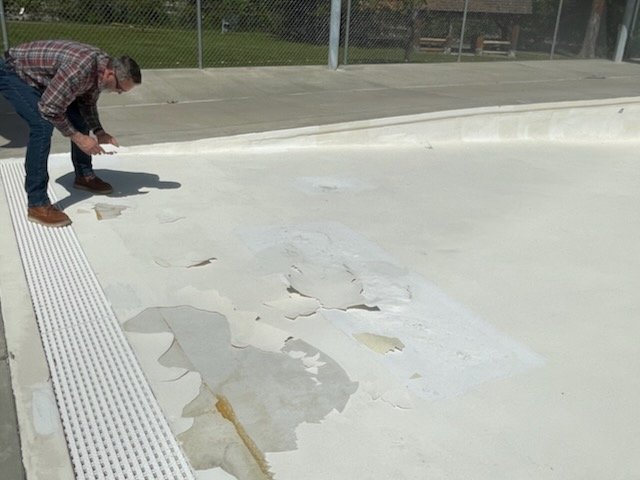FUNDS RAISED for 2025 Wagner Pool repairs!
THANK YOU TO EVERYONE WHO DONATED TO GET THE TWISP POOL BACK IN OPERATION FOR 2025!
Cracked & peeling liner in the zero-depth entry area of Wagner Pool, May 2024.
HOORAY!
The Friends of the Pool has raised $195,000 as of April 8, 2025, enough to meet the request of the Town of Twisp to fund the estimated cost of immediate repairs and support operations needs in 2025.
The known repairs to the Wagner Pool liner, to fix another known drain leak, and to patch concrete cracks that are discovered upon liner removal, and provide ~$60,000 towards operating expenses so we will have enough funding to cover staff costs, heating, and equipment/materials supplies. This is enough to get the contractor started on repairs next week!
April 15th, Tuesday, at 5:30, the Twisp Town Council will hold a special session to review the donation agreement and recommend the pool be opened for 2025,at which time, Friends of the Pool will transfer funds to the Town. It’s open to the public, so come celebrate with us!
Friends of the Pool would like to thank the 76 generous donors who contributed to the effort, plus the ~100 anonymous supporters who enjoyed a glass at Ryzo, or chipped in at community yoga at Motive Yoga, who gave sage advice, and a kind word of support. We are all so excited to play and swim at the Wagner Pool in summer of 2025! Thank YOU!
Splashing, laughing and swimming at the pool in 2025 are due to these generous donors.
What was needed to open Wagner pool for summer 2025?
The Town of Twisp Public Works hired pool contractors to evaluate needs during the 2024 pool closure, determining these repairs would keep Wagner pool physically operational for 5-7 years.
Roof patches: $10,000 (Complete!)
Leak detection in the concrete pad/decking: $5,000 (Complete!)
Leak repairs surrounding the drains: $5,000 (Complete!)
Electrical Panel replacement: $7,500 (Complete!)
Liner replacement: $160,000 ($6000 deposit made to reserve spring work)
Boiler replacement: $25,000 (in 2-3 years)
The Friends of the Pool (FOP) provided $40,000 to Twisp to start these repairs in autumn 2024. Many are complete, as you can see!
In order to reopen THIS year, 2025, the last massive repair to tackle is replacing the pool liner, which costs around $160K. Contractors estimate that this new pool liner will give the community approximately 5-7 years of pool use before it again needs to be replaced. This work is reserved on the contractor’s schedule - we just need to raise the money!
Plus, FOP provides annual funding to aid the Town of Twisp in paying for the day-to-day staffing, maintenance and operations of the pool - $60,000 for 2025.
Keeping Wagner Pool running for a few more years buys us time as a bridge to the next pool. The pool will be run as it is in its current location for that time while FOP simultaneously plans and fundraises for a replacement pool in a different site.
Why do these fixes need to happen (again)? Didn’t the liner just get repaired a few years ago?
Yes, the liner repair only holds back the leaks for 5-7 years - but it’s been 8 since the liner was replaced.
Most simply, through meetings with hydrologists, we’ve learned that the Wagner Pool was built on top of an aquifer, at its location at the confluence of the Twisp and Methow Rivers. This means that as underground water levels fluctuate in the spring and summer along the river, the pool slightly rises and falls too. The pool is made of concrete which is not a flexible material. The fluctuating water levels cause the pool to form small cracks, which have been accumulating over 60 years. This leads to an unnecessary amount of costly repair work which could be avoided in a location with a lower water table or with more modern engineering and material like steel. For ecological and financial reasons, a different location would be far more suitable for a pool.
It’s not too late to chip in for Wagner Pool!
Funds will be be necessary to keep the pool operational each year - so your gift keeps the Methow swimming!


